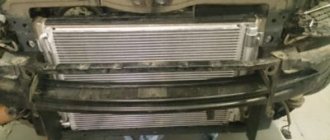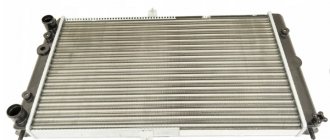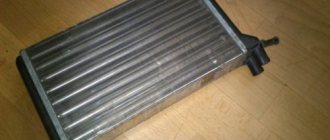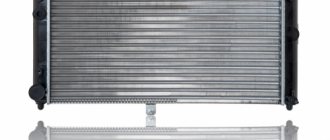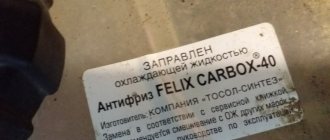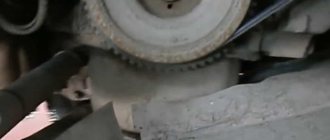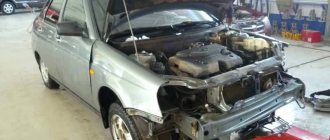Sooner or later, even the most reliable and simple car part wears out and requires replacement. First of all, this concerns technological and complex structural elements. The VAZ-2110 radiator is just such an element of the cooling and heating system for a living room. If a copper radiator is installed rather than a regular one, it can be successfully repaired and reinstalled. Regular aluminum radiators, unfortunately, cannot be repaired. Therefore, today we will replace two radiator radiators at once on the tenth family - the old and new models.
This device consists of:
- core (the so-called cooling part);
- lower and upper boxes (or, in other words, tanks) with pipes.
The core is tubular-lamellar. It is made of brass. In appearance, these are rows of oval tubes, which are arranged in a checkerboard pattern. These tubes are soldered with special cooling fins. The upper tank of the device is equipped with a filler neck, which has a sealed plug complete with outlet and inlet valves. The lower tank is equipped with a tap. The coolant is drained through it.
Which engine radiator and heater should I choose?
A car is a complex device that consists of various systems. One of them is the (CO) cooling system of the power unit. If any part of it fails, a whole series of problems immediately arise. The main thing is engine overheating. Most often this happens because the radiator is not working well.
At the same time, every driver wants to feel comfortable at any time of the year and especially in winter. This involves creating a warm, cozy environment in the cabin. But often, due to clogging of this automotive component, as well as corrosion processes, the VAZ 2110 heater radiator fails and requires repair or replacement.
Therefore, let’s try to figure out which unit is best to choose for the engine and for the stove so that it lasts long and reliably. Such a high-quality device will help in the operation of the cooling system in particular, and the entire car in general.
Most often, repair of this device is required due to its leakage. This is affected by corrosion and, of course, the quality of the materials used in its manufacture. In order for this car part to last longer, it should be looked after. Dirt, dust, leaves contaminate the cooling radiator of the VAZ 2110 and it begins to “perform its duties” much worse.
Because of this, as soon as summer begins, it is better to wash it. You can, of course, clean it of dirt with your own hands (more on that below), or you can also visit a car wash. These devices are distinguished by composition, namely: aluminum and copper. Let's look at them in more detail:
- aluminum models are less expensive and lighter. However, they also have disadvantages. These include lower thermal conductivity and greater susceptibility to corrosion.
- Copper analogues are distinguished by metal strength and durability (they resist corrosion better). Copper also has higher thermal conductivity, and, accordingly, higher efficiency.
I would like to note that companies often produce radiators for both the engine and the heater. The model will depend on the size of the power unit. A device (old model) is suitable for a 1.5 liter engine, but a heat dissipating “part” from Priora (this is a new model) is perfect for a 1.6 liter engine. But before purchasing, you need to check what type of device (radiator) your car is equipped with.
When and what kind of heater radiator was installed on the VAZ-2110
- By mid-2003, all tenths of the VAZ family had DAAZ aluminum radiators with catalog number 2110-8101050 installed.
- After 2003, the 2110 model was equipped with improved coolers. Its catalog number is 2110-81010160-00.
Prices
The price for a native DAAZ radiator should not exceed a thousand rubles. The following heaters will sell for approximately the same money:
- Luzar;
- Craft;
- Pramo LRZ;
- Boutler;
- Finord and many other manufacturers.
These are all aluminum heat exchangers, so their prices are not very high.
Aluminum or copper?
A copper cooler will cost more, but it's worth it.
A good copper radiator will cost about twice as much, but it’s worth it: firstly, the thermal power of copper is greater, secondly, a copper radiator has high thermal inertia (it takes a long time to heat up, but cools down slowly), thirdly, if damaged, a copper radiator the radiator can be easily repaired, cleaned, damaged elements replaced, and it will be much cheaper than replacing the stove with a new one.
In addition, copper is virtually resistant to corrosion when it comes to the life of the car. If you have decided on your choice, we assemble the tool, diagnose the heating system and replace the radiator with a VAZ-2110.
How to remove the cooling radiator of a VAZ-2110?
The cooling system of the 2110 car is a closed type, liquid, with forced circulation. The overall tightness is ensured by the exhaust and inlet valves, which are located in the plug of the expansion tank of the machine.
Thanks to the exhaust valve, the required increased (compared to atmospheric) pressure in the system on a hot engine is maintained (the temperature at which the liquid boils increases, as a result, steam loss decreases).
At a pressure of 1.1-1.5 kgf/cm2 it opens. If the pressure decreases, the inlet valve opens. The entire thermal regime of the power unit is maintained by an electric fan and thermostat. The fan is turned on by a sensor that is screwed into the left tank. If you need to remove the radiator, then:
- drain the coolant on a cooled engine;
- dismantle the electric fan;
- slightly loosen the clamps and then carefully remove the supply and steam exhaust hoses;
- Next, loosen the clamp and dismantle the outlet hose.
- tilt the radiator towards the engine and remove it.
- At the bottom of the device, the emphasis is placed on two rubber pads. During assembly, they must fit firmly into the holes of the cross member.
Assembly is carried out in the reverse order of disassembly.
When to change the radiator?
A heater radiator leak is an indisputable failure; it is immediately noticeable, if not by traces of antifreeze under the car, then by a drop in the liquid level in the expansion tank.
It is much more difficult when there seem to be no leaks, but at the same time, the radiator does not heat even at a high antifreeze temperature. In this case, the reason for the drop in heater temperature may be either a clogged or coked radiator, or a number of other reasons:
- air lock in the cooling system;
- non-working thermostat;
- breakdown in the hot air distribution system;
- air leakage through leaks in air ducts (this is a proprietary disease of the entire tenth family);
- low level of antifreeze in the expansion tank.
Antifreeze leaks under the radiator are a clear reason to look for a leak.
Heating system diagnostics
In short, before buying a new radiator or removing an old copper one for repair, you need to check the entire cooling system in detail so as not to throw money away.
By the way, about money and wind - at the service station they will ask for at least 2 thousand rubles to replace the heater radiator. Therefore, it is cheaper to do all the work of replacing the heater core yourself.
Replacing the heater core
One of the main reasons why the stove on a VAZ 2110 malfunctions is the leakage of antifreeze. Most often, antifreeze runs out directly from the radiator or through holes due to loose fastening of the hoses. The process of removing and subsequent replacement of this auto part is a very specific topic, about it in detail below. Now I would like to note that to replace it, you do not need to remove the panel in the cabin. All actions take place exclusively under the hood.
VAZ 2110 heaters are distinguished:
- old model (until September 2003);
- new model (after September 2003).
The procedure for replacing a device of a new and old model is not very different, but still, there are differences. At first the procedure is the same.
First, drain the antifreeze:
- This can be done from the engine block. To do this, unscrew the tank cap (this is necessary so that the pressure drops) and the drain plug, which is located behind the ignition module. About four liters of antifreeze should run out into the substituted container.
- You can also drain it through the expansion tank. To do this, you will need to remove the hose from the stove and thus pour out 1 liter of antifreeze. Then we remove the rubber pipe and loosen the three clamps. Further, depending on the type of heater (old or new), the procedure is slightly different.
Recommendations
Please note, when changing the radiator of a VAZ 2110, replacing the antifreeze (completely), then you also need to drain the coolant from the engine block. The fact is that draining the liquid only from the radiator is not enough to completely replace the antifreeze.
To drain the remaining coolant, you will need to unscrew the drain plug on the block, after which the coolant will drain. It is also recommended to flush the cooling system when replacing the radiator as part of a complete coolant change. To do this, you can use special compounds, citric acid or ordinary distilled water. We also recommend reading the article on how to replace the heater radiator of a VAZ 2114. From this article you will learn when and why you need to change the heater radiator, as well as how to replace the heater radiator 2114 with your own hands.
In general, washing comes down to the following:
- after installing a new radiator, the old antifreeze is completely drained from the system;
- then the system is filled with flushing liquid in full;
- then the engine starts and warms up until the cooling fan turns on;
- after warming up, the flushing is completely drained from the system;
- new antifreeze is poured into the system in full;
If, when draining the flush, it is noticed that the drained liquid is very dirty, the flushing procedure must be repeated. This will extend the service life of the filled coolant (TOSOL or antifreeze), increase the efficiency of the cooling system, and also increase the life of the cooling system parts (radiator, pipes, pump, thermostat, etc.).
Before dismantling and replacing the radiator of the VAZ-2110 stove, it is important to understand the main reasons why it may break down.
These include:
- Heater radiator VAZ 2110
- leaking vehicle heater radiator;
- reduction or cessation of heat transfer from the vehicle.
In the event of the first breakdown, a puddle of antifreeze will appear under the vehicle, so this problem cannot go unnoticed. In addition, this coolant has a specific odor that will immediately spread throughout the interior of the car.
The appearance of the second reason may be accompanied by a number of problems, such as:
- The system contains too little or no coolant.
- The thermostat is damaged.
- There is an air lock in the cooling system.
- Damage to the car's oven damper.
- Regulator malfunction.
- The heater core is clogged.
In other words, you shouldn’t immediately blame the heater radiator for all the problems; you should rule out other possible causes of failure, including those related to the heating and cooling system. To exclude these causes, you need to check whether there is antifreeze in the tank, whether the thermostat is in working condition, check the block and the heater damper motor.
It is important to carry out one more small diagnosis, which is extremely important before dismantling the radiator of the VAZ-2110 stove. Warm up the vehicle engine, climb into the engine compartment, both pipes should have the same temperature (upper and lower), you can simply check this with your hand. Turn the heat and cold control knob all the way to the right. Then you need to turn on the heater fan. If the radiator is broken, in the first 15-20 seconds a hot stream of air will emanate, which will gradually become colder.
As a rule, all the spare parts needed to repair the VAZ-2110 heater radiator come in old and new types. Until 2003, samples of the old type were used, later they began to be replaced with new ones. It is worth noting that these two radiator models are completely non-interchangeable, so before purchasing you must immediately select the right model. The new model has serial number 21110-8101060-00, the old one has 2110-8101050.
There are quite a lot of manufacturers of heater radiators for the VAZ-2110 on today’s market, but the highest quality ones are those produced by DAAZ. All other models will heat less and fail faster.
Let's consider the necessary tools with which it will be possible to replace the radiator of the VAZ-2110 stove of the new model:
- crosshead screwdriver;
- coolant vessel;
- head 10 with ratchet;
- key to 13;
- key to 17.
Let's look at the step-by-step instructions for replacing the heater radiator on a VAZ-2110:
- First drain the coolant (antifreeze). To do this, place a vessel under the engine in the place of the drain hole, use the 13th key to unscrew the plug and wait for the antifreeze to flow out. Then you need to unscrew the expansion tank. If you decide to immediately replace the coolant in the system, then you will additionally need to drain it from the cooling radiator.
- We remove all the clamps and pipes of the expansion tank. Now you need to disconnect the fastening belt and remove the tank itself. Next you need to remove the seal on the hood. To do this, all fastening elements are removed from the soundproofing sheathing. You should also remove all those with plastic clamps. Using a 10 mm ratchet wrench, unscrew the nuts used to secure the trim to the body.
- At the next stage, disconnect the chip located on the lid of the brake cylinder reservoir.
- Then you need to disconnect the fitting with the hose located on the vacuum booster. Using a 10mm wrench, remove the brake nuts from the vacuum booster. In this case, you should not unscrew the pipes from the master brake cylinder; it is simply moved to the side until it stops.
- In the vehicle interior we find the brake light switch and disconnect the wires from it.
- Using a 13mm wrench, disconnect the nuts securing the brake pedal bracket to the car body.
- Now that everything is disconnected, you can move into the motor bay. Pull out the brake booster, bracket and pedal. Pulling out is carried out by scrolling, otherwise nothing will work. Access to the radiator is open, and now nothing will interfere with its replacement.
- At the final stage, unscrew the worm-type clamps located on the steam exhaust pipes, disconnect the micromotor connector for the damper control and disconnect the screws securing the radiator to the heater body.
- Now you need to remove the old radiator, clean the niche from debris, dirt and leaves and install a new one.
- We put it back together exactly the same way we took it apart. A new radiator for the VAZ-2110 stove has been installed.
So, following the described instructions, it will not be difficult to change the heater radiator on a VAZ-2110 car yourself.
Sources
- How to replace or repair the stove on a VAZ-2110
- ladaprofi.ru/vaz-2110/kak-pravilno-snyat-i-pomenyat-radiator-na-vaz-2110.html
- etlib.ru/report/346-zamena-radiatora-pechki-vaz-2110-starogo-obraztsa
- remont-inomarki.ru/radiator-otopitelja-vaz-2110.html
- zen.yandex.ru/media/your_auto_portal/zamena-radiatora-pechki-vaz-2110-5acbcce7dcaf8e42c2ae2000
- luxvaz.ru/vaz-2110/106-zamena-radiatora-pechki.html
- drive2.ru/l/8467624/
- vazweb.ru/desyatka/otoplenie/zamena-radiatora-pechki.html
Sooner or later, any, even the most reliable and simple part in a car, wears out and requires replacement. First of all, this concerns technological and complex design elements. The VAZ-2110 heater radiator is just such an element of the interior cooling and heating system. If we have a copper radiator installed that is not standard, it can be successfully repaired and installed back. Regular DAAZ aluminum radiators, unfortunately, cannot be repaired. Therefore, today we will replace two heater radiators at once on the tenth family - the old and new models.
Replacing an old-style heater core
We remove the car rubber seal of the wind lining and frill. We unscrew the screw that secures the frill (under the main brake cylinder). We unscrew the four screws on the right side of the frill. We unhook the two clamps on the frill that secure the hoses and wires.
Carefully disconnect the minus wire of the fan from the engine body, and also disconnect the positive terminal. Then unscrew the two screws of the frill (left side) and move it forward a little (but do not remove it completely). remove the windshield trim. After this, you need to disconnect the terminal of the sensor that monitors the coolant level.
Next, remove the steam removal hose from the expansion tank. Continuing further, disconnect the washer hose. You also need to unscrew four screws. We remove the windshield wipers and windshield trim. After this, we need to remove the clamps of the stove and fan housing. However, not all. Heater housing clamps only.
The next step is to unscrew the screws of the filter and the front part of the fan (they are the same, with the exception of only four long ones. It is better to remember their location). Now we remove the front of the stove fan. Afterwards, remove the filter housing. Next you can remove the back of the fan. Now we loosen the clamps a little and begin to remove the supply hoses, steam exhaust hose and antifreeze return.
We remove the leaking radiator. We carry out the necessary actions and collect everything in strictly reverse order. It is important to take into account some points during assembly: it is necessary to correctly mount the plastic housing of the “heating” fan, so that the pedal fits into the desired groove. There should be no extra bolts, all parts should fit tightly. If this does not work out, the micromotor gearbox will not be able to move the dampers and the stove will not heat.
Choosing a heater radiator for VAZ 2114, 2113, 2115
Which radiator to choose for the stove on a VAZ 2114? This question is gaining relevance in connection with the approaching winter. It's no secret that not all domestically produced cars have a good heater. Let's try to figure out which radiator to choose:
Copper radiator.
Immediately after purchase, the copper radiator has a heat output of 389.6 W/(m. deg).
The properties of copper are such that such a radiator takes a long time to heat up and takes a long time to cool down. The number of fins in a copper radiator is smaller than in an aluminum one, and the cross-section of the channels is smaller. Therefore, they clog faster and the stove blows cool air at idle. Most often, this is what VAZ owners complain about. The advantages of a copper heater radiator include its maintainability. This is where the advantages end. And the disadvantages begin: recently, manufacturers have been saving on raw materials and using impure copper. Some paint radiators to give them a marketable appearance, but this reduces the heat transfer of such a radiator. Lately it has been very difficult to find a high-quality copper radiator.
Aluminum radiator.
The heat output of the aluminum radiator is 209.3 W/(m deg).
This radiator heats up quickly and cools down quickly. The number of fins in an aluminum radiator is much greater than in a copper one, which is a definite plus. The cross-section of channels in an aluminum radiator is also larger than that of a copper radiator. Thanks to this, they do not clog longer and have greater heat transfer.
The disadvantages of an aluminum radiator include its non-repairability in case of leakage.
So which radiator should you buy?
Just a few years ago, the answer to this question would have been: copper. But time passes and today it is difficult to find a high-quality copper radiator. Therefore, our choice at the moment: aluminum.
However, we do not recommend buying painted radiators, because... their heat transfer is lower and an unpleasant odor may appear in the cabin.
Of the companies, we do not recommend buying heater radiators manufactured by Luzar. There are too many negative reviews about them.
How to prepare the VAZ 2114-15-13 stove for winter.
In order to avoid problems with the interior heater in winter, we recommend doing the following:
- Replace the coolant and flush the entire cooling system.
- Replace the interior heater radiator with a new one.
- Replace the engine cooling radiator with a new one
- Change the pump.
- Remove air from the cooling system.
These steps will help you avoid heat problems in the winter. Replacing radiators will help avoid contamination of the coolant, and replacing the pump will guarantee its normal circulation in the system.
The new “type” of heater is attached to the car body like this:
- a screw in the middle, which is located at the bottom end of the windshield;
- 2 nuts are located above the exhaust manifold;
- 1 nut is located in the left corner (close to the filter).
You need to remove the rear window washer fluid reservoir, if there is one. We remove the filter, which is attached to the heater with a plastic cover with 4 screws. The stove consists of 2 parts. They are connected by three self-tapping screws. The heater fan is equipped with an air supply hose. You can look through it and see a self-tapping screw that needs to be removed along with two smaller screws.
We separate the stove into two parts. This is done as follows. We take the corresponding part of the device with each hand and turn it up a little and, then, carefully remove the right side, and after that, the entire part. Remove the right side. After this, we dismantle the steam exhaust hose. The right side, like the left, consists of two parts. They are connected by iron brackets.
They need to be removed. The part will split into two parts (here, between them, there is a seal). Now we will have access to the damper. It is better to use a new aluminum damper. Having carried out the necessary steps, we carry out the assembly in the reverse order.
New cooling system
The sequence of your actions in this case is as follows:
- First of all, for safety reasons, disconnect the negative terminal of the battery. We drain the cooled antifreeze or antifreeze, first opening the expander cap. To drain the liquid you will need a container with a volume of 4-5 liters.
- Now, after unscrewing the two nuts, remove the wipers from the car.
- Then we dismantle the released protective plastic cover under the windshield, which is secured with 2 nuts and 4 self-tapping screws.
- To access the stove, remove the frill of the car by unscrewing 5 self-tapping screws, 1 screw and 2 nuts located at the bottom, in the middle of the frill, in the area of the steering rack.
- In order to remove the stove, remove the yellow cross brace, if any, as well as the curved bellows of the air filter.
- We pull the chokes off the radiator pipes.
- Then disconnect all electrical wires from the stove terminals.
- At the steering rack, unscrew 2 nuts that secure the heater, 1 nut securing the heater to the body.
- We unscrew the 3 screws connecting the two halves of the stove.
- We take it out by swinging the right side of the stove, first moving it to the right.
- The radiator in the removed half of the stove is secured with 3 screws. We take it out and replace it with a new one, not forgetting to put on the foam seal. We check the operation of the fan and, if necessary, repair it or replace it with a new one.
- Before installing the assembly, it is advisable to rinse the coolant supply hoses with running water.
- Assembly is carried out in reverse order.
Do-it-yourself radiator cleaning
There are situations when you notice that the engine begins to overheat. In this case, it is necessary to check how the car’s engine cooling system works. The main “blow” from dust, dirt, poplar fluff, and leaves is taken by the radiator. As a result, it overheats and fails. Therefore, let's try to figure out how and, most importantly, with what, to clean it.
The concept of “cleaning” a radiator can be considered mainly from the following two positions: in the first case, if it needs to be cleaned from the outside, that is, its surface needs to be washed. The second option is to wash the insides of this device. The presented methods will allow you to achieve some positive results, but they require completely different amounts of effort and time.
In the photo you can see a radiator that is contaminated with poplar fluff. Next, we’ll look at how best to clean it from dirt (before work, be sure to make sure it’s cooled down).
Stories from our readers
“Fucking basin. "
Hi all! My name is Mikhail, now I’ll tell you a story about how I managed to exchange my two-wheeler for a 2010 Camry. It all started with the fact that I began to be wildly irritated by the breakdowns of the two-wheeler, it seemed like nothing serious was broken, but damn it, there were so many little things that really started to irritate me. This is where the idea arose that it was time to change the car to a foreign car. The choice fell on the melting Camry of the tenth years.
For a radiator to last longer , it needs to be looked after. Due to dust, dirt, poplar fluff, and leaves, the radiator becomes dirty and begins to cope with its duties worse, so at the beginning of summer it is recommended to flush the radiator . Those who are not afraid of dirt clean it with their own hands, but you can also order such a service at a car wash.
Car radiators are distinguished by their composition as aluminum and copper.
Which radiator is better, copper or aluminum ? All the advantages of an aluminum radiator in less weight and price. The disadvantages include lower thermal conductivity and are easily corroded. Advantages of copper radiators: copper is a more durable metal, so such radiators are more durable (more resistant to corrosion). In addition, copper has higher thermal conductivity, that is, higher efficiency.
Cleaning the radiator from the outside
If you need to clean the cells of the device, then you can use the following options:
- washing with Karcher. This type of washing is based on a special high-pressure water cleaning technology. This method is very effective, but there are also negative reviews (they complain that the honeycombs are bent this way). But in reality, you just need to learn how to use the sink correctly. To safely use a Karcher, it is better to use not a “cutter” as an attachment, but a “vario”. You can use maximum speed. However, direct washing is not recommended. Better at a distance of 30-50cm. In this case, the angle must be right;
- There is also a similar method, but here air is used instead of water. The result is cleaning with compressed air. Without a doubt, there will be a positive effect, but how long it will take to wash the radiator is up to you to decide;
- Another option if you decide to clean the heat dissipation device is to use a nylon brush and soapy water. Actions should be performed in the direction of the radiator mounts, otherwise the metal will be damaged. The cleaning agent must be applied directly to the unit, wait a while (information about this is contained in the instructions for the product) and wash off the dirt with a regular watering hose.
What are the differences between an aluminum radiator for a VAZ stove and a copper one?
As for the copper radiators of the VAZ stove , they have higher heat transfer, which significantly affects the heating of the cabin, and the copper from which they are made practically does not corrode, therefore, such a radiator will serve much longer than an aluminum one. True, the price of the VAZ 2110 copper radiator is also different, it costs more and there is not a large selection of them. Among the high-quality radiators, I would like to note Iranian-made radiators, Orenburg radiators (OR LLC) and SHAAZ
An aluminum stove radiator has low heat transfer and is more susceptible to corrosion, but its price is lower than copper and it weighs less. Due to the low cost of aluminum, there are many more manufacturers producing such radiators. Of these, first of all, I would like to note the radiators of the DAAZ , which are installed at the manufacturer. Also good heater radiators for VAZ cars from the manufacturers “KRAFT” and “LUZAR”
Sources used:
- https://krutimotor.ru/zamena-radiatora-vaz-2110/
- https://mashinaa.ru/avtovaz/vaz-2110/7616-radiator-pechki-na-vaz-2110-zamena-vybor-cena-remont.html
- https://carfrance.ru/radiator-pechki-vaz-2110/
- https://avtika.ru/kakoy-vybrat-radiator-ohlazhdeniya-dlya-dvigatelya-vaz-2110/
- https://remontauto-vaz.ru/page/kakoj-radiator-pechki-vaz-2110-luchshe
Cleansing inside
If in the case of external cleaning all actions can be performed directly on the car, then for internal cleaning it is impossible to do without removal. First you need to drain the coolant. For this:
- place a container under the valve;
- unscrew the lid;
- turn off the valve;
- when all the liquid runs out, close the valve.
To clean the “core”, you need to direct a stream of water inside. When the radiator is full, you need to drain the water using the valve. This procedure should be carried out several times. If the contamination is severe enough, special cleaning fluids can be used. When the cleaning is completed, install the radiator in the car.
Don't forget to pump out any air pockets. To do this, it is necessary to run the engine with the lid open for about 15 minutes. Then you should turn on the heater to maximum. This will cause the coolant to circulate and the air will disappear. Another way is to drive the front wheels onto a hill. After this, you need to let the engine run for several minutes at high speeds.
Recommendations
Please note, when changing the radiator of a VAZ 2110, replacing the antifreeze (completely), then you also need to drain the coolant from the engine block. The fact is that draining the liquid only from the radiator is not enough to completely replace the antifreeze.
In general, washing comes down to the following:
- after installing a new radiator, the old antifreeze is completely drained from the system;
- then the system is filled with flushing liquid in full;
- then the engine starts and warms up until the cooling fan turns on;
- after warming up, the flushing is completely drained from the system;
- new antifreeze is poured into the system in full;
If, when draining the flush, it is noticed that the drained liquid is very dirty, the flushing procedure must be repeated. This will extend the service life of the filled coolant (TOSOL or antifreeze), increase the efficiency of the cooling system, and also increase the life of the cooling system parts (radiator, pipes, pump, thermostat, etc.).
Source
← We replace the heater radiator on a VAZ 2110. We start the radiator fan of the VAZ 2111 in manual mode →
Friday, September 12, 2014 / Views: 17852VAZ cooling systemTags: heater radiator, VAZ 2110 repair
The radiator of the VAZ 2110 stove , like all its parts, becomes unusable over time. Due to the action of antifreeze or antifreeze, the internal surfaces become corroded and destroyed over time. These destructions, in turn, lead to the fact that the radiator of the VAZ stove begins to leak. The way out of this situation is to replace it or repair it (soldering). In this material we will talk about how to choose the best heater radiator , which will heat better and last longer than the one that was on your car.
There are two types of VAZ 2110 heater radiators on the domestic automotive parts market:
- Copper stove radiators
- Aluminum stove radiators
Do-it-yourself VAZ 2110 radiator repair
If the VAZ 2110 radiator is leaking, then there are certain malfunctions that should be taken into account. In this situation, many owners resort to replacing it. However, oddly enough, in most cases you can get by with the usual repair of the VAZ 2110 radiator, rather than purchasing a new unit. Often you do not need to have special skills, but there are also cases when you cannot do without knowledge in the field of soldering and welding. To do this, you should learn to determine the real condition of the car and then begin repairs on your own.
The most common problem is device leakage. In such situations, the coolant runs out from the places where the metal and plastic are attached, and this leads to overheating of the power unit. It is not always possible to find a new device, and repairs, in turn, will cost 2 times less. Next we will talk about repairing the heater core and engine cooling system.
Which radiator is better: copper or aluminum cooling radiator
Before replacing the cooling radiator, it is necessary to choose the right high-quality analogue. Today you can buy a VAZ 2110 radiator made of aluminum or copper, the part is offered from various manufacturers.
- An aluminum radiator is lighter in weight and more affordable. At the same time, the thermal conductivity of such a solution is lower, and there is also a higher tendency to corrosion. In any case, if we consider the aluminum radiator of the VAZ 2110, the price will be 25-30% lower than for copper radiators.
- A copper radiator is more durable and better resists corrosion, which increases the service life of this element. Copper also conducts heat better, which improves the performance of the engine cooling system. The main disadvantage of copper radiators is their higher cost and fewer available options on the market.
As for popular manufacturers and costs, the 2110 Kraft radiator will be the most affordable. You can also opt for Luzar or DAAZ. It is important to understand that the price of a VAZ 2110 radiator should not be the main deciding factor. The first place should be the quality of the product and full compliance with the engine, taking into account the displacement.
Repair using chemicals
Minor damage can be repaired using special products, namely radiator restoration fluid, powder restorers or sealant. The principle of their operation is approximately the same: the product must be poured into the engine cooling system. The resulting mixture clogs cracks if it comes into contact with air.
Of course, not all chemistry is the same, therefore, in general, it is not possible to answer for the quality. For example, a low-quality reducing agent can cause harm. It will clog the entire cooling system. Thus, the stove will stop heating and, as a result, it will be necessary to flush the system or replace the stove radiator. Thus, for repairs, chemistry is only a temporary solution to the problems that have arisen.
What is this?
By radiator, motorists and service station specialists understand a device that removes heat from the liquid circulating in the engine cooling system. This spare part is located in the front part of the hood.
The radiator consists of the following elements:
- Bottom tank.
- Core.
- Pipes.
- Coolant drain tap.
- Upper container.
Untimely cooling leads to expansion of motor parts . This causes the pistons to jam in the engine cylinders. As a result, the power unit becomes unusable.
Common car radiator malfunctions include the following:
- Violation of the tightness of the seals.
- Depressurization of pipes.
- Clogged tubes.
- The appearance of cracks on the lower or upper tank.
In order to suspect problems in the car radiator in time, you need to know what signs they manifest themselves. It's time to change this spare part if:
- The motor is overheating.
- Traces of antifreeze appear under the car.
- The power unit does not start.
- Smoke is coming out from under the hood.
If such signs occur, you should contact a mechanic as soon as possible. The specialist will conduct diagnostics and identify the cause of the malfunction. As a rule, the entire radiator has to be replaced.
You can try to repair the radiator using soldering
The repair area should be thoroughly cleaned and a piece of sheet brass (brass devices) should be soldered to it. In such a situation, you need to use a gas torch and a soldering iron. If the tubes are cracked, it is better to replace them with new ones. The solder should be heated until it becomes soft. Then we remove the tube from the tank and
solder a new one in its place. The main disadvantage of this method is that exposure to high temperatures leads to deformation of the elements of the unit. Thus, we came to the conclusion that it is better to use argon arc welding for repairs.
Soldered radiators
| high heat transfer low cost of equipment no need for a massive rubber gasket (with a plastic tank) | complex production process (possible defects due to insufficient connection of tubes with tapes) no tube protection |
Cooling lamella plates are cut out of aluminum tape. They have “blinds” to trap air, holes for tubes and “stops” that determine the distance between the plates. |
Plastic turbulators are placed in round radiator tubes to improve heat transfer. |
Each finished radiator is tested at a pressure exceeding the working pressure. There are no leaks. |
Radiator grille upgrade
In addition to the bumper grille, the grille can also be beautifully modified. If you equip your car with a mesh, the top grille will not only act as protection, but will also look aesthetically pleasing. The factory grille is constantly “weared out” by time, flies, roads, leaves. As a result, the varnish peels off and peels off in places.
The appearance is not attractive and something needs to be done about it. First you need to remove the grate and scrape out all the animals from it. Then everything needs to be washed well. Afterwards, you can start “cutting” from the mesh. Everything needs to be measured accurately. Next you need to remove the old varnish, degrease and paint all the elements.
The color design can be very different. It is necessary for everything to dry. Next, using a screwdriver and pliers, you should secure everything. The end result will look like in the photo.
Modification of the VAZ 2110 fan
Since the fan of the VAZ 2110 engine cooling system operates only at one speed, many owners do not like the peculiar jumping behavior of the arrow on the instrument panel. In addition, I would like to smooth out the abrupt shutdown of the fan. But first we should note the main disadvantages of the cooling system:
-there is a “thermal pumping” effect (the temperature, if it’s hot outside, constantly fluctuates);
- shock electrical loads on the vehicle on-board network.
Let's now take a closer look at the operation of the radiator fan: many owners of the VAZ 2110 do not like the fact that if the weather is hot outside and the car is not moving quickly, the coolant temperature rises close to the red zone on the dashboard of the corresponding sensor, and then the fan starts and the arrow drops down. It is swaying. Perhaps the panel is lying.
But the effect is still unpleasant and alarming. All drivers probably want to make the temperature “control” smoother. Owners want the temperature to be maintained at the same level at all times.
There are constant debates about this, but there is a solution to this problem
Option 1. The first method involves reducing the rotation speed of the Carlson and starting the electric motor more smoothly, at a low coolant temperature. But this option is relatively difficult for a person who does not understand car electrics. In general, the entire structure will not look very reliable due to the large number of wires.
Option 2 . This method is somewhat simpler than the previous one. It involves forcing the fan to turn on using a button. After this modification, the interior will be complemented by one more detail, namely a button. In the summer, standing in a traffic jam, you can press it and the interior will be filled with the measured rumble of the Carlson. It operates at low speeds as long as the button is pressed (this speed is enough to ensure that the coolant temperature does not exceed 90-95 degrees). However, if it rises above the marked value, the factory second maximum speed will turn on.
Option 3 . This approach, according to car enthusiasts, although not the cheapest, is probably the most correct and, more importantly, reliable. It involves installing a Smooth Control Unit for the Car Radiator Electric Fan. In general, this is a combination of advantages and a qualitative elimination of the disadvantages of cooling systems due to the introduction of a new algorithm, the so-called smooth control, which regulates the rotation speed of the electric fan. As a result, the engine temperature stabilizes. The cost of such a device is approximately 1200 rubles.
Option 4. Another option is the Fan Start Controller (FRC) for cars. This adapter is installed in the open circuit of the car fan power supply. It turns on more smoothly, and this increases the service life of the fan.
Which radiator is better: copper or aluminum cooling radiator
Before replacing the cooling radiator, it is necessary to choose the right high-quality analogue. Today you can buy a VAZ 2110 radiator made of aluminum or copper, the part is offered from various manufacturers.
- An aluminum radiator is lighter in weight and more affordable. At the same time, the thermal conductivity of such a solution is lower, and there is also a higher tendency to corrosion. In any case, if we consider the aluminum radiator of the VAZ 2110, the price will be 25-30% lower than for copper radiators.
- A copper radiator is more durable and better resists corrosion, which increases the service life of this element. Copper also conducts heat better, which improves the performance of the engine cooling system.
As for popular manufacturers and costs, the 2110 Kraft radiator will be the most affordable. You can also opt for Luzar or DAAZ. It is important to understand that the price of a VAZ 2110 radiator should not be the main deciding factor. The first place should be the quality of the product and full compliance with the engine, taking into account the displacement.
Here are the main ones. Let's start with the simplest ones:
- the bolt that attaches the plastic fan to the pulley has come loose;
- the radiator is not inserted into the socket and just lies on the suspension;
- part of the impeller blade broke off, resulting in an imbalance;
- there is dirt on the impeller, there is also an imbalance (it needs to be cleaned);
- due to the fact that the cushions are pressed, the motor does not hold up and there is vibration (you need to change the cushions, install special rubber gaskets);
- no lubrication, the fan is humming (the electric motor needs to be lubricated);
- broken bearing (it needs to be replaced).
To balance the impeller, you must:
Option 1 . By winding the wire around the blades, we check the imbalance. We gradually level it out until there is silence.
Option 2 . It is necessary to insert into the hole a part that is suitable in diameter (drill). Place the impeller with its axis on two horizontal supports. If there is an imbalance in this situation and the impeller tends to take an unclear position in space, this malfunction should be eliminated by grinding the blades. You can also glue a weight inside the impeller.
If, after the above reasons, vibrations and noise remain, then you should change the fan impeller, which will have eight blades (four blades come from the factory). Or finally make soundproofing. After replacement, the fan will definitely not work any worse. Most often, after replacing the fan with an eight-blade one, the vibrations and noise disappear, and driving in the car will now be very comfortable.
